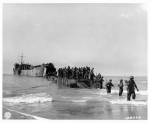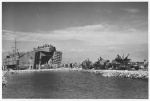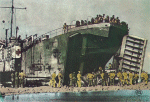Click On Image
For Full Size Image |
Size |
Image Description |
Source |
 |
232k |
USS LST-386 underway towing a section of a Rhino barge. Further pontoon sections are carried on each side amidships, date and location unknown.
US Navy photo from "Allied Landing Craft and Ships of World War Two" by the US Division of Naval Intelligence. |
Robert Hurst |
 |
249k |
USS LST-386 unloading troops onto a causeway at Licata, Sicily, date unknown. Note the improvised runway for light
planes US Army L4 (Grasshopper) observation planes visible above the main deck.
US Army Signal Corps photo. |
Raymond Cvetovich, Ph.D. |
 |
218k |
USS LST-386 beached while unloading French troops and vehicles at Provence, France in August 1944
Note the steel pontoon (Rhino Ferry) secured to her starboard side. The second photo is a colorized cropped version of the photo made into a French postcard.
US Navy photo. |
(1016038604)-Raymond Cvetovich, Ph.D.Ed
(1016038601)-Storey, Joe Radigan MACM USN Ret., and Tommy Trampp |
 |
351k |




